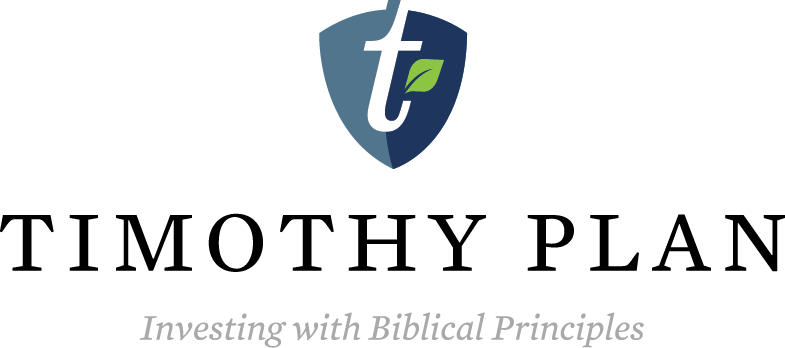Defensive Strategies 1Q19
May 1, 2019
Recent Posts
- A Businessman Who Really Did Give it All Over to GodSeptember 28, 2022
- A 'Screwtape' Approach to Keeping Christians from Biblically Responsible InvestingSeptember 21, 2022
- Both Inflation and Inaction Are UnbiblicalSeptember 14, 2022
- Misunderstood in the NeighborhoodAugust 18, 2022
- Billy Graham was the inspiration for the new BiblegraphAugust 9, 2022
- A Businessman Who Really Did Give it All Over to God
Categories

Investing involves risk, including the potential loss of principal.
Before investing, carefully consider the fund’s investment objectives, risks, charges, and expenses of the investment company. This and other important information can be found in the fund’s prospectus. To obtain a copy, visit TIMOTHYPLAN.COM or call 800.846.7526. Read each prospectus carefully before investing.
Because the Timothy Plan Funds do not invest in excluded securities, the Funds may be riskier than other funds that invest in a broader array of securities. There are risks when a fund limits its investments to particular sized companies, and all companies are subject to market risk. The Fund recently experienced significant negative short-term performance due to market volatility associated with the Covid-19 pandemic.
MUTUAL FUND INVESTOR
To read more about our mutual funds, please click this link to access fund information, including the prospectus, fact sheets, performance, and holdings for each fund.A prospectus is available from the Fund or your financial professional that contains more complete, important information. Please read it carefully before investing. Mutual Funds distributed by Timothy Partners, Ltd. Member FINRA.
HEADQUARTERS: 1055 Maitland Center Commons, Maitland, FL
(800) 846-7526 | Send an email | View our mapMUTUAL FUND SHAREHOLDER SERVICES: c/o Ultimus Fund Solutions, Post Office Box 541150, Omaha, NE 68154-1150
(800) 662-0201 | Account AccessETF INVESTOR
To read more about our ETFs, please click this link to access fund information, including fact sheets, performance and holdings for each fund. A prospectus is available from the Fund or your financial professional that contains more complete, important information. Please read it carefully before investing. ETFs distributed by Foreside Fund Services, LLC, Member FINRA. Timothy Partners, Ltd. is not affiliated with Foreside Fund Services, LLC.
ETF SHAREHOLDER SERVICES: Contact your financial advisor for information regarding your account.






Macquarie Investment Management
US REIT • Client commentary • March 31, 2019
MARKET REVIEW
US equity markets bounced back from the dismal fourth quarter of 2018 — featuring the weakest December since 1931 — with the S&P 500® Index’s strongest first quarter since 1998. Global markets also were up, though not as much. In fact, risk assets around the globe, including bonds and commodities, were all strong in the first quarter of 2019.
The driving force behind the turnaround was the US Federal Reserve’s decision to forgo further rate hikes in 2019. In December, after raising rates for the fourth time in 2018, the Fed had stated it planned three additional hikes in 2019. Shortly before the first quarter closed, however, it backed off, saying there would be no further hikes in 2019. Additionally, the Fed said it would end its balance sheet reductions by September.
Although the decision was positive for global risk assets, it left investors to ponder just how data-dependent the central bank’s decision-making is, given that credit markets and macroeconomic indicators had been slowing throughout 2018. The Fed’s pivot was unprecedented, and many investors are now questioning the central bank’s mandate.
Nonetheless, the real estate investment trust (REIT) market clearly benefited from this course change, with the FTSE Nareit Equity REITs Index recording a 16.33% total return for the first quarter, which was higher than its cumulative return for 2016- 2018. Although fundamentals did not drastically change for the overall REIT group in the first quarter, the credit and interest rate environment improved, driving returns higher.
That raises the question: Do REITs only perform well in a declining rate environment? The answer is both yes and no. Economically sensitive sectors (apartments and industrial, for example) and stable sectors (like manufactured housing) can do well in rising markets while long-duration sectors (such as healthcare and shopping centers) may experience greater headwinds.
Data: Bloomberg.
Within the strategy
For the first quarter of 2019, the US REIT strategy (the “Strategy”) underperformed its benchmark, the FTSE Nareit Equity REITs Index.
Technology stock selection was positive as the Strategy’s weighting in cell towers outperformed. Cell towers generally have stable cash flow and are a basic oligopoly with only three major players. The Strategy owns one of them: American Tower Corp., up more than 20% for the first quarter. The company has predictable cash flow from long leases and low capital expenditures (capex) and stands to benefit as the industry transitions to 5G technology. The Strategy is underweight data centers, with Equinix Inc. as its only holding. Equinix serves the retail market and has a repeatable interconnection business that we believe is more attractive than the wholesale and hyperscale businesses of Digital Realty Trust Inc. and Cyrus One Inc. The Strategy has taken some profits in American Tower as it has become expensive, but we continue to hold Equinix.
The Strategy’s performance in the self-storage sector benefited from an underweight relative to the benchmark. The group is struggling with slowing street rates (leading to slowing rent growth) and rising expenses. Supply of self-storage facilities has risen four times over the past three years. Construction levels are at all-time highs and may peak this year. However, given that it typically takes 45 months to fully lease a new facility, the negative effect of oversupply could linger into 2020. The positive, in our view, is that this business requires low capex. Once rate deceleration stabilizes, net-operating-income (NOI) growth may improve. In addition, because expenses are higher this year due to real estate taxes, we may see better year-over-year comparisons next year. However, until we see signs of stabilization, we intend to maintain the Strategy’s underweight.
The Strategy outperformed in the specialty sector primarily due to strong stock selection, specifically Invitation Homes Inc. and EPR Properties. Both stocks rose more than 20% during the quarter. Invitation Homes benefited from the strong desire for home rentals, and we believe this should continue to drive strong internal growth. EPR Properties benefited from its exposure to long duration leases. As the bond market rallied, investors sought secure and growing income. We remain confident in these two stocks, as we feel stable income growth should be rewarded in the current market.
As was the case at the end of 2018, the Strategy’s underperformance in the first quarter was predominantly due to issues in the healthcare sector. Shares of Brookdale Senior Living Inc., the main detractor, declined for the quarter. Although the company gave guidance below analysts’ expectations, Brookdale Senior Living announced that senior housing fundamentals would bottom in the fourth quarter. We continue to believe in the company’s value proposition. The company has been an arduous holding for the Strategy, but we think 2019 will mark an inflection point. First, its real estate is undervalued by half. Second, the company has an ancillary business to which the market has assigned no value, but which we think is worth $250 million to $300 million. Given that the company’s market cap is only $1.2 billion, the market is assigning a value of just $900 million to Brookdale’s senior housing assets, grossly undervaluing the company, in our view. Yet there is a frenzy for senior housing assets as buyers expect that over the next five years, there could be strong upside from a demographic tailwind.
In the lodging sector, stock selection and an underweight allocation resulted in underperformance. The Strategy’s lack of exposure to Park Hotels & Resorts Inc., Gaming and Leisure Properties Inc., and Ryman Hospitality Properties Inc. hurt performance. We believe that although hotels have rallied with the market, from here on they will likely show minimal growth as valuations are stretched.
The diversified sector detracted from performance, as the Strategy’s lone holding in the sector, Vornado Realty Trust, rallied but lagged the broader market. The company owns a large amount of office and retail assets around Penn Station in New York City. The company’s current plans to redevelop the assets have caused near-term pressure on the stock; however, we believe the longer-term value creation will be substantial. We continue to like the Strategy’s exposure to the name.
Outlook
Since 2018’s fourth-quarter selloff, REITs have rallied strongly. With the Fed ruling out additional rate hikes this year, REITs now have the wind at their back. That may not last, however, if the market should sense that conditions are improving and that rates could rise in China, Europe, or the United States.
So far, the declining earnings growth rate for the S&P 500 Index has helped REIT shares. However, with REITs trading at a discount of just 1% to NAV and an adjusted funds from operations (AFFO) multiple of 21x, they are clearly more expensive now than they were at the end of 2018.
Given this backdrop and current valuations, we believe we are beyond the point of an “everything rally” due to the Fed’s pivot. As we await first-quarter earnings, and given the strong rally that has already taken place, the bar is now higher for companies to justify their valuations. We continue to overweight manufactured housing, apartments, and freestanding while underweighting malls, shopping centers, and data centers.
One technical aspect worth discussing is fund flows. The REIT industry is entering its fifth year of negative fund flows. This has occurred for several reasons. First, investors fled yield and gravitated toward growth when the Fed raised rates in 2017 and 2018. Second, after nearly an eight-year recovery, REITs have achieved full occupancies as rent growth has slowed in many sectors. Lastly, some of the outflow resulted from Japanese funds that were created by US REIT managers to enable retail investors in Japan to buy US REITs. The Japanese funds initially attracted $61 billion by promising yields of 25% to 30%. When the Japanese watchdog equivalent of the US Securities and Exchange Commission blew the whistle on this irresponsible promise, investors fled the funds, leaving just $30 billion. REIT investors bore the brunt of this bad behavior. Our firm never participated in this practice. We believe that an investment in our Strategy has the potential to provide a sustainable and stable dividend and steady cash flow growth. We seek to achieve 9% to 11% growth over the long term.